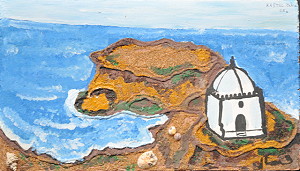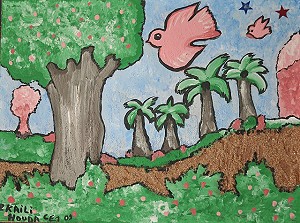Introduction
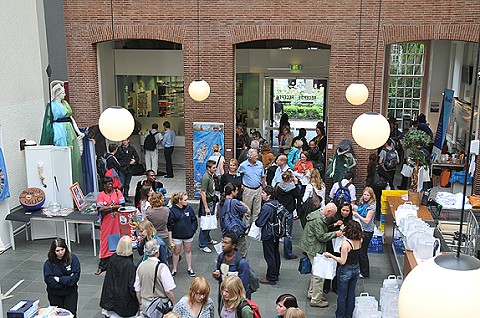
Having worked largely separately from the perspectives of their very different working conditions, they were confronted with each other's production and - finally - had some chance to meet face-to-face and explain their conditions and approaches to one another.
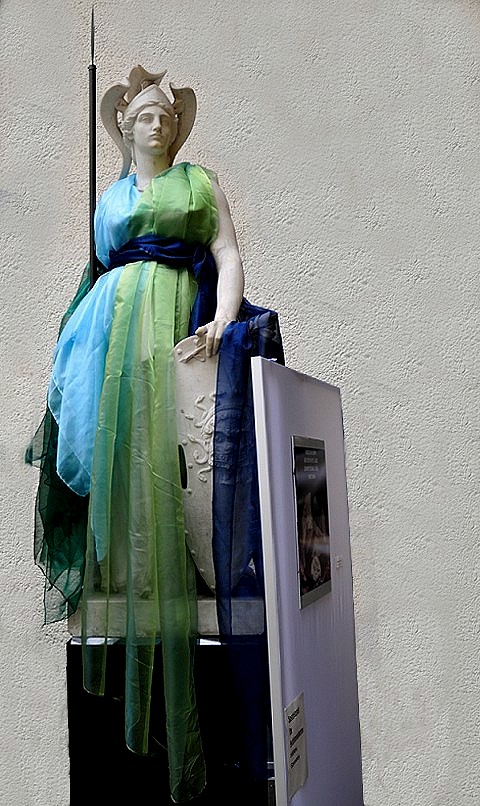
In Senegal, they are also connected to underinvestment into schools and thus few, if any, alternatives to fishing are available to young people in Kayar. Many have left in pirogues on the dangerous trip to the Canary Island trying to reach Spain and the EU in search of a better future. Many perish on this hazardous route from lack of water and food or drowned.
In the Niger Delta the anger and despair are great: the petroleum wealth of the region does not trickle down to the inhabitants, they only get the pollution and the violence surrounding the attempts to get a piece of the cake with force and the counter-violence of those wanting to protect the installations and keep people at bay.
The contrast could hardly be starker. Yet we are inextricably connected through the trade in fish, petroleum and guns, something that we did not think about in those terms before, but which became palpable during the exhibition.
Philomène Grégoire, an Initiative member in Amsterdam, organised a workshop during the MARE conference and the exhibition. It was centered on how we can also connect in playful ways with one another, while telling each other stories about our painted hands.
Have a look at her 'Hands on' workshop on YouTube, kindly prepared by Moira van Dijk. The pictures show moments of the workshop.
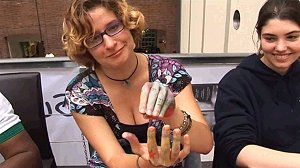 |
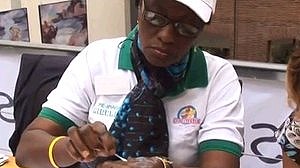 |
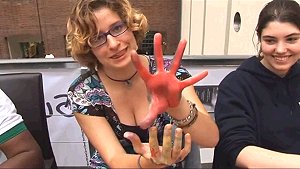 |
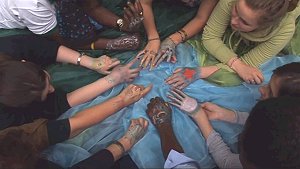 |
The mini-brochure about the exhibition can be downloaded here (780KB, pdf, format A4, original A5).
Photographs courtesy P. Bottoni.
Sponsored by Achte Ausstellungssysteme GmbH, Hilden, Germany.
Section Hilden, Germany
The group of the Helmholtz-Gymnasium Hilden (HGH) brought a diverse set of works to the exhibition, all crafted around the concern for the sea, its fragility, but also its beauty and how people relate to it in stories, real life, myths. The range of techniques reached from acryl paintings, to installation with mixed techniques and artistic photography. The large-scale photographic prints were kindly sponsored by the local plant of 3M.
|
1. Fabian Preiss 2. Bettina Jurek The thoughts are free, who could guess them, they pass flying like nightly shadows, nobody can know them, no hunter can shoot them, still – the thoughts are free. 3. Marita Schmeinck Message of the sea. The sea only speaks to those, who are willing to listen. 4. Nele Hannig Tjark Evers was 21 years old when he was on his way to visit his parents on Baltrum from Christmas Eve 1866. By mistake he left the boat, when he considered a sandbank to be the looked-for island in dense fog. These are his last thoughts before he drowned, written down in a farewell letter: “Dear parents, dear brothers and sisters. I am standing on a sandbank and must drown. I will never see you again. May God have pity with me and console you.” 5. Diana Ulbricht For a kiss from her lips, I would give everything I have, my goods and chattels and my soul. 6. Gianna Heintges From the dark depth of the sea the Venus role quietly, as the nightingales called in the grove she was choosing. And the waves fettled becoming a mirror to catch her image, because the Venus herself disappeared forever. Smiling she granted the water the last glance out of which the sea took its glow up to today. 7. Robin Bläsing |
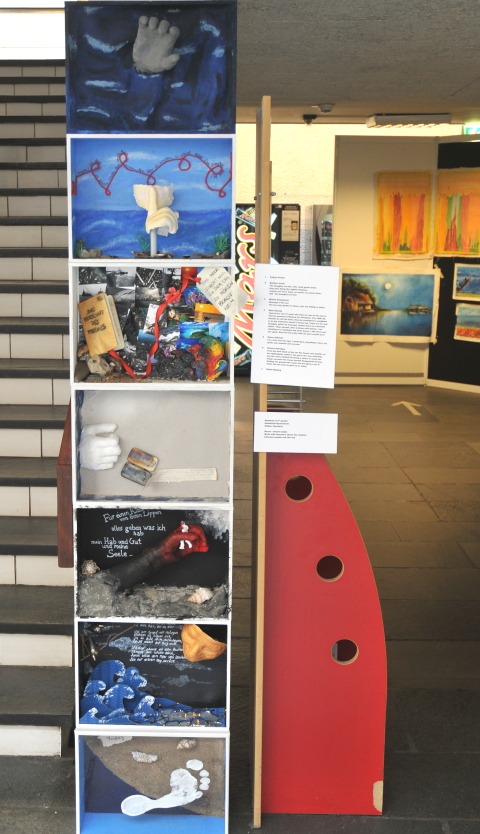 |
| Different authors Theme: The beauty and exploitation or degradation of the coral sea and its creatures Acryl and mixed media |
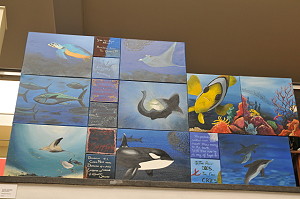 |
Section Brussels, Belgium
The group of the European School Brussels I in Uccle brought a mixture of new and updated existing work, including mixed-media installations and paintings. The common thread was the concern about research findings projecting the disappearance of known fisheries by about the year 2050 if current overfishing trends were to continue. Marine pollution was also thematised as were the problem of inequitable North-South relations. The works were selected based on themes also discussed at the MARE conference.
|
Eleonora Maggiore
Humans will suffer the consequences of their lacking respect for the sea.
Water colours and mixed media on recycled canvas
|
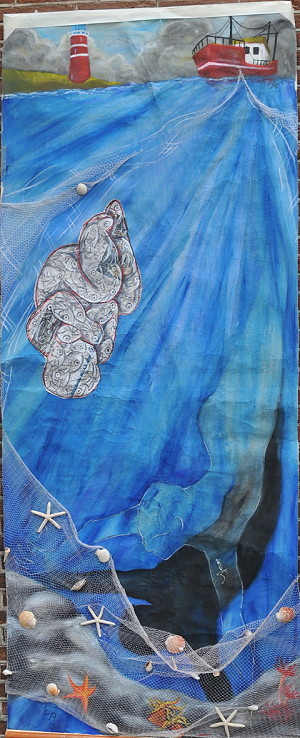 |
|
Giulia Bottoni
Bluefin tuna (Thunnus thynnus L.) in the Mediterranean has no chance against modern spotting and fishing techniques. Juveniles get caught for fattening in floating cages in quantities way above what scientists say can be caught safely. To feed the caged tuna, fish perfectly fit for human consumption as far away as West Africa gets caught. It's 'good business' for those earning perhaps as much as 100,000 Euro for a single tuna specimen on Tokyo's fish market. You might not be aware of the dire situation this massive overfishing has provoked for the very survival of this majestic and delicious fish when you enjoy a fashionable sushi or sashimi plate. But according to available data, the population of Bluefin tuna has collapsed to a small fraction of what it was only 30 years ago. This is why the Principality of Monaco has demanded that the trade of Mediterranean bluefin tuna be prohibited under the CITES Convention regulating trade in species of wild fauna and flora threatened by extinction.
The WWF had a long-standing campaign to save this emblematic species from terminal decline. Mixed media installation |
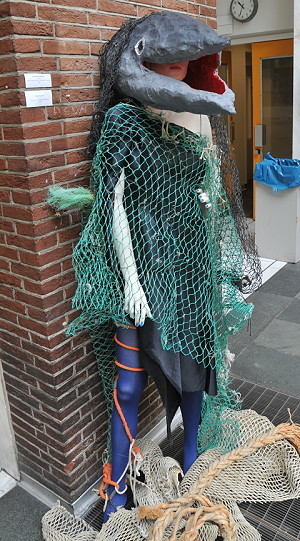 |
|
Ségolène Jeanjean
Timeline
Acrylic |
 |
Section Kayar and Dakar, Senegal
Here are the first few images of drawings and paintings from youth of Kayar and Dakar. Some are by pupils who have already had some more training in painting techniques, while some did not yet have regular instructions. The themes addressed are of several types - reflecting local maritime culture, the pride and dangers of the fishermen, the myths surrounding the sea, but also reflections on research results and observations pertaining to rarefaction of the resource, pollution and other challenges.
|
Different authors
The images are partially naturalistic, partially representing myths from around the sea
|
|
|
Different authors
The images are partially naturalistic, partially representing myths from around the sea
|
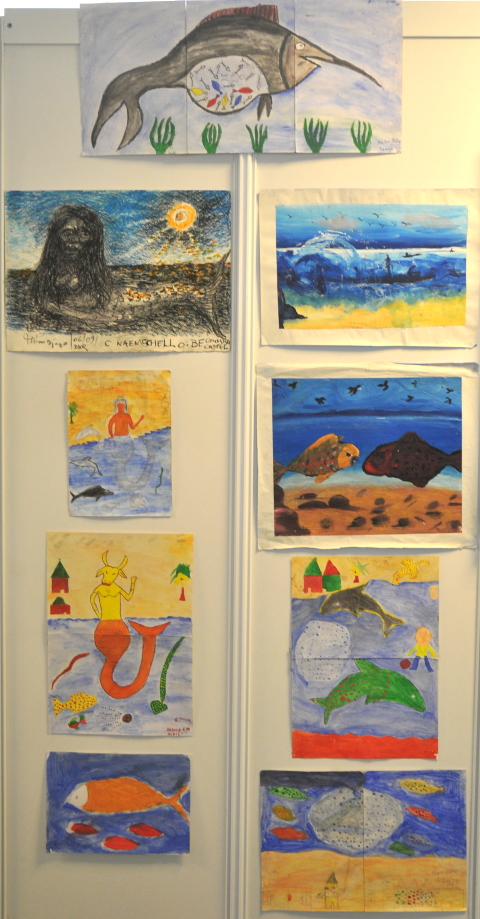 |
If you want to learn more about the context into which the youth works are embedded, notably how Kayar fishermen are loosing out to industrial fleets from elsewhere, but also showing how the dramatic decline of the resource base and with it the fishing communities is not confined to Kayar, watch the documentary on YouTube fittingly entitled 'Cry Sea' by film directors Cafi Mohamud and Luca Cusani.
Section Niger Delta, Nigeria
Three artists of the group 'Magnificant 10 Finger Artists' (MAFAS10) in Nigeria were represented with works in Amsterdam. Their National Coordinator, Nduwhite Ndubuisi Ahanonu, who is also Nigeria's cultural ambassador to Berlin, Germany, was also present during the exhibition together with Prof. Stella Williams from Ile Ife University. Both interacted with the groups from other countries and exhibition visitors.
The pupils of the Peace Clubs of three schools in the Niger Delta participated in a workshop end May 2009 organised by Nduwhite Ndubuisi Ahanonu and fixed their experiences with fisheries, oil-related violence and environmental conditions in drawings and paintings. The schools are Stella Maris College, Port Harcourt, Community Secondary School Abuluma and Community Secondary School Okochiri, Okrika, all in Rivers State. The modest means at disposal meant that a number of drawings were done only with pencils and colour pens and are thus more difficult to reproduce than the acryl colour works.
Albums
Section Safi, Morocco
Resulting from the work carried out during weeks of activities exploring and documenting marine biodiversity along the coasts of Safi, the five wood tables painted with mixed media and materials, including sand, shells and acryl colours, have been sent to the Initiative and shown during the exhibition "Sustainable Seas Through the Eyes of Art", Amsterdam, Netherlands, from 9 to 11 July 2009.
|
Kastal Zahra, CE4
The sea is a paradise, where many people can stay at ease. This chapel, holy place, is constructed at the edge of the blue, bottomless, endless, sea, to protect her from bad things the destroyers of the ocean might do to her. This sea, which is dear to us, is the symbol of freedom. |
|
|
Skili Houda, CE1
No title
Here is how I imagine the places around the sea: Humans and animals coexist peacefully. The greenary is a symbol of serenity - but how dirty are our coasts, how many birds are poisoned by waste! Hence, let's do something to save our seas. |
|
|
Skili Najlae. CE6
A dream island
An island where calm governs. It means freedom. In the middle of this island, palm trees dance joyfully, enjoying the pure air which they breathe. The fresh air comes from the sea guarded by people with good common sense. Nearby, one sees a floating boat, symbol of life. A dream island! |
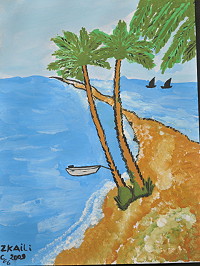 |
|
Salma El Idrissi, CE4
No title
This painting represents a large ship floating calmly in the middel of the vast ocean. The blue of the sea indicates that it is not contaminated by pollutants. The sea may thus be a healthy place, where one can live happy moments, without fear. |
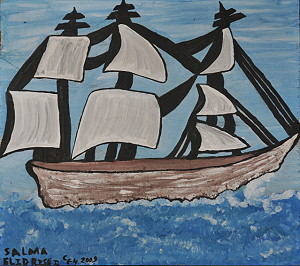 |
|
Assiya Fadlaoui, CE4
No title
My painting represents the evolution of pollution. The shells symbolise the maritime creatures which are most badly affected. Hundreds of them are victims of destruction humans inflict on nature. The blue space in the interior of the big shell represent all that is healthy, but it is not much! |
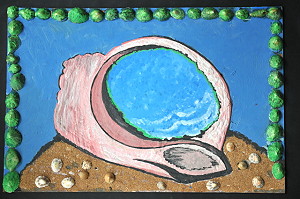 |































































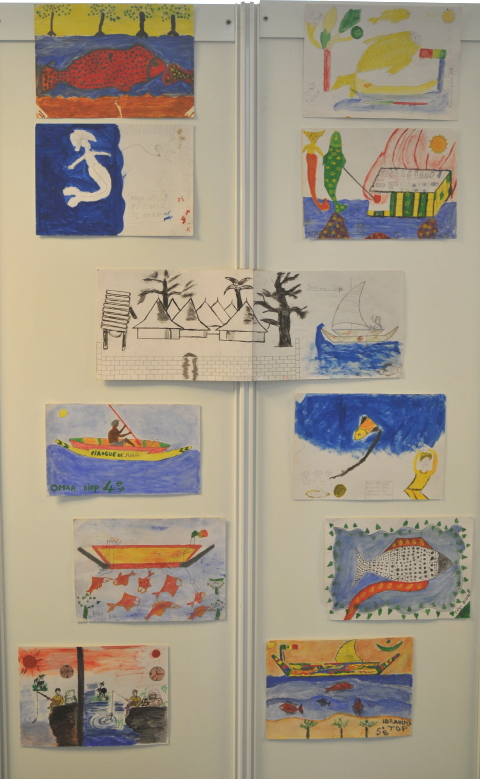




















![Alfred Nemi, Community Secondary School Okochiri, Okrika -
Tilapia -
More biological and distribution information about tilapia (Oreochromis aureus) a brackish water species reported from Nigeria in FishBase [www.fishbase.org] -
Pencil drawing with mixed media (45.5 cm x 31 cm)](https://www.mundusmaris.org/plugins/content/admirorgallery/admirorgallery/thumbs/Amsterdam090709_Nigeria/N09_7954NemiAlfred2Web.jpg)



![Tobiahs Taribibia, Community Secondary School Okochiri, Okrika -
Prawn and bony fish -
The prawn might be Southern pink shrimp (Farfantepenaeus notialis) - for more biological information see SealifeBase [www.sealifebase.org]. -
Bony fish might be the Blue Runner (Caranx crysos) - for more biological information see Fishbase [www.fishbase.org]. -
Pencil drawing with pen colours (45.5 cm x 31 cm)](https://www.mundusmaris.org/plugins/content/admirorgallery/admirorgallery/thumbs/Amsterdam090709_Nigeria/N09_7959TobiahsTaribibiaWeb.jpg)



![Victor Chindah Maruchi, Stella Maris College, Port Harcourt -
Drawing depicting militants in speed boat, a person in a boat trying to get out of their way and marine life, including a squid and a dolphin
For more biological information on marine organisms, see SealifeBase [www.sealifebase.org]. -
Pencil drawing and water colours (45.5 cm x 31 cm)](https://www.mundusmaris.org/plugins/content/admirorgallery/admirorgallery/thumbs/Amsterdam090709_Nigeria/N09_7963MaruchiVictorChindahWeb.jpg)
![Paul Enyinnaya, Stella Maris College, Port Harcourt -
The government should provide a specific place for the oil spillage to avoid water pollution - drawing depicting an oil deposit with gas flaring, canoes with fishermen, marine life and a hut on stilts. -
In 2005, the NGO Friends of the Earth International, among others, campaigned against gas flaring and its negative effects on the climate and people's health. Read more [http://www.climatelaw.org/cases/cases/case-documents/nigeria/report/index_html]. -
Pencil drawing with pen colours (45.5 cm x 31 cm)](https://www.mundusmaris.org/plugins/content/admirorgallery/admirorgallery/thumbs/Amsterdam090709_Nigeria/N09_7964PaulEnyiannayaWeb.jpg)

